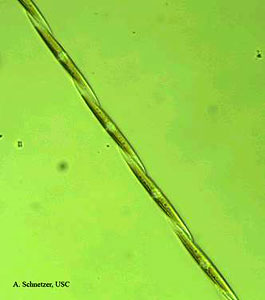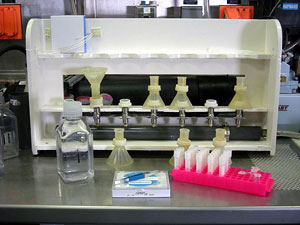

 | |||||||||||
|
|
Journals 2008/2009Heather Judkins
August 15, 2008 One of the projects onboard this cruise concerns HAB's, harmful algal blooms which are occurring more frequently off the west coast of the United States in the last 10 years causing problems for both marine life and humans. The group of diatoms, Pseudo-nitzschia, are responsible for the blooms. What are diatoms you ask? Diatoms are single celled, microscopic, plant-like organisms that are found in oceans and freshwater systems around the world. There are approximately 100,000 species of diatoms living today.
The Psuedo-nitzchia group carry a toxin, domoic acid, within their cell wall. These organisms are eaten by numerous others and the toxin is brought up the food chain via zooplankton, crabs, oysters, birds and marine mammals. The biomagnification of the toxin has harmful impacts to the higher-level animals. Seals, sea lions, birds, and sea otters are the most affected by the biomagnification. Once enough domoic acid accumulates inside the body, a marine mammal begins to act "crazy." For example, sea lions have been known to beach themselves and have an odd head weaving behavior related to the high domoic acid levels in their tissues. The goal of the HAB project is to gain an estimate of how much domoic acid is in the marine waters off the west coast of the United States. Local studies in Monterey Bay have been done and this is the first broad study of the Pacific Ocean in this region. Six times a day, water samples are collected from the surface waters along the transect line. They are then filtered and the small sample is stored in the freezer until they reach the lab. At the lab, liquid chromatography is used to determine the levels of domoic acid in the water.
This study is important because a baseline for domoic acid needs to be established in order to predict trends in the level of domoic acid. What's the baseline? How much is harmful? What role does global warming play in these outbreaks of blooms? Human health reasons are also important as the acid lies within the tissues of many organisms we eat, such as oysters and crabs. People can become ill if they eat contaminated organisms. Question 1: What algal blooms occur in our area? What organism causes it? Question 2: What is the formula for photosynthesis? |
||||||||||

